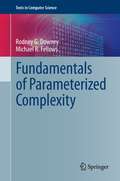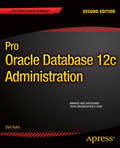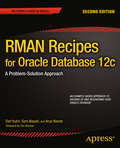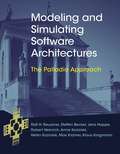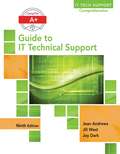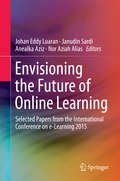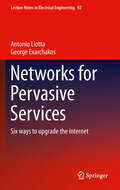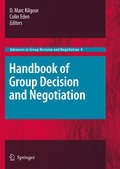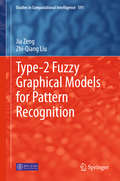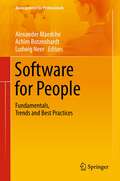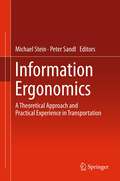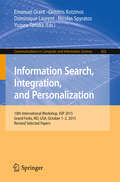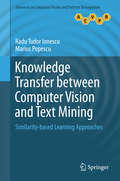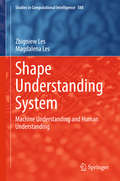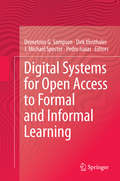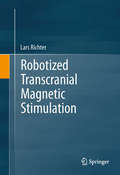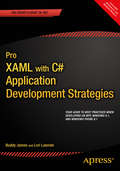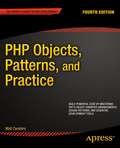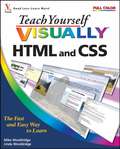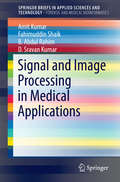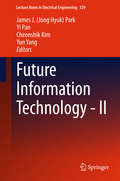- Table View
- List View
Fundamentals of Parameterized Complexity
by Rodney G. Downey Michael R. FellowsThis comprehensive and self-contained textbook presents an accessible overview of the state of the art of multivariate algorithmics and complexity. Increasingly, multivariate algorithmics is having significant practical impact in many application domains, with even more developments on the horizon. The text describes how the multivariate framework allows an extended dialog with a problem, enabling the reader who masters the complexity issues under discussion to use the positive and negative toolkits in their own research. Features: describes many of the standard algorithmic techniques available for establishing parametric tractability; reviews the classical hardness classes; explores the various limitations and relaxations of the methods; showcases the powerful new lower bound techniques; examines various different algorithmic solutions to the same problems, highlighting the insights to be gained from each approach; demonstrates how complexity methods and ideas have evolved over the past 25 years.
Pro ASP.NET MVC 5 Platform
by Adam FreemanThe power of ASP. NET MVC 5 stems from the underlying ASP. NET platform. To make your ASP. NET MVC applications the best they can be, you need to fully understand the platform features and know how they can be used to build effective and elegant MVC framework applications. The ASP. NET platform provides ASP. NET MVC applications with a rich suite of services including vital every-day features like extensible request handling, state management, and user authentication. Understanding how these features work is the difference between creating an average web application and the best-in-class. MVC applications that are architected with a thorough knowledge of the underlying platforms are faster to write, faster to run, and more readily adaptable to change. In Pro ASP. NET MVC 5 Platform, best-selling author Adam Freeman explains how to get the most from the entire ASP. NET platform, beginning with a nuts-and-bolts description of the patterns and tools you need through to the most advanced features. He goes in-depth at every stage to give you the practical knowledge that you need to apply these concepts to your own code. What you'll learn Understand how ASP. NET MVC 5 is built on the ASP. NET platform. Create scalable MVC framework web applications that work in harmony with the underlying platform Understand the ASP. NET Lifecycle and how it affects the whole ASP. NET stack Extend and Customize the ASP. NET platform to suit your MVC5 web application Who this book is for The book is ideal for anyone wanting to use ASP. NET MVC 5 in a professional context. It works particularly well as a compliment to Adam Freeman's other ASP. NET MVC titles Pro ASP. NET MVC 5, Pro ASP. NET MVC 5 Client, and Expert ASP. NET Web API 2 for MVC Developers. Table of Contents Part 1. Getting Ready 1. Putting the ASP. NET Platform in Context 2. Patterns and Tools Primer Part 2. The ASP. NET Platform Foundation 3. The ASP. NET Lifecycles 4. Modules 5. Handlers 6. Disrupting the Request Lifecycle 7. Detecting Device Capabilities 8. Tracing Requests Part 3. The ASP. NET Services 9. Configuration 10. State Data 11. Caching Data 12. Caching Content 13. Get Started with ASP. NET Identity 14. Applying ASP. NET Identity 15. Advanced ASP. NET Identity"
Pro Oracle Database 12c Administration
by Darl KuhnPro Oracle Database 12c Administration is a book focused on results. Author Darl Kuhn draws from a well of experience over a decade deep to lay out real-world techniques that lead to success as an Oracle Database administrator. He gives clear explanations on how to perform critical tasks. He weaves in theory where necessary without bogging you down in unneeded detail. He is not afraid to take a stand on how things should be done. He won't leave you adrift in a sea of choices, showing you three ways to do something and then walking away. Database administration isn't about passing a certified exam, or about pointing-and-clicking your way through a crisis. Database administration is about applying the right solution at the right time, about avoiding risk, about making robust choices that get you home each night in time for dinner with your family. If you have "buck stops here" responsibility for an Oracle database, then Pro Oracle Database 12c Administration is the book you need to help elevate yourself to the level of Professional Oracle Database Administrator. Condenses and organizes the core job of a database administrator into one volume. Takes a results-oriented approach to getting things done. Lays a foundation upon which to build a senior level of expertise
RMAN Recipes for Oracle Database 12c: A Problem-Solution Approach
by Darl Kuhn Arup Nanda Sam AlapatiRMAN Recipes for Oracle Database 12c is an example-driven approach to the Oracle database administrator's #1 job responsibility: Be able to recover the database. Of all the things you are responsible for as database administrator, nothing is more important than the data itself. Like it or not, the fearsome responsibility of protecting your organization's most critical data falls squarely upon your shoulders: Lose that data and your company could fail. Lose that data and you could be out of a job. Oracle's flagship database product fortunately implements a wide-ranging feature set to aid you in the all-important task of safeguarding against data loss. Recovery Manager, or RMAN, is at the heart of that feature set, and is the tool most-often used to initiate database backup and recovery operations. In this book, well-known authors and database experts Darl Kuhn, Sam Alapati, and Arup Nanda have created a set of examples encompassing the gamut of backup and recovery tasks that you might need to perform. Sometimes, especially when the heat is on, a good example is what you need to get started towards a solution. RMAN Recipes for Oracle Database 12c delivers. It'll be the book you reach for when that dreaded call comes in at 3:00am some dreary morning. It'll be the book that lets you sleep at night knowing that no matter what transpires, that you've done your job well and can recover from any outage. RMAN Recipes for Oracle Database 12c gets right to the point with quick and easy-to-read, step-by-step solutions that can help you backup and recover your data with confidence.
Modeling and Simulating Software Architectures: The Palladio Approach
by Heiko Koziolek Robert Heinrich Max Kramer Jens Happe Ralf H. Reussner Klaus Krogmann Steffen Becker Anne KoziolekToo often, software designers lack an understanding of the effect of design decisions on such quality attributes as performance and reliability. This necessitates costly trial-and-error testing cycles, delaying or complicating rollout. This book presents a new, quantitative architecture simulation approach to software design, which allows software engineers to model quality of service in early design stages. It presents the first simulator for software architectures, Palladio, and shows students and professionals how to model reusable, parametrized components and configured, deployed systems in order to analyze service attributes.The text details the key concepts of Palladio's domain-specific modeling language for software architecture quality and presents the corresponding development stage. It describes how quality information can be used to calibrate architecture models from which detailed simulation models are automatically derived for quality predictions. Readers will learn how to approach systematically questions about scalability, hardware resources, and efficiency. The text features a running example to illustrate tasks and methods as well as three case studies from industry. Each chapter ends with exercises, suggestions for further reading, and "takeaways" that summarize the key points of the chapter. The simulator can be downloaded from a companion website, which offers additional material. The book can be used in graduate courses on software architecture, quality engineering, or performance engineering. It will also be an essential resource for software architects and software engineers and for practitioners who want to apply Palladio in industrial settings.
CompTIA A+ Guide to IT Technical Support
by Jean Andrews Joy Dark Jill WestThis step-by-step, highly visual text provides a comprehensive introduction to managing and maintaining computer hardware and software. Written by best-selling author and educator Jean Andrews, A+ Guide to IT Technical Support, 9th Edition closely integrates the CompTIA+ Exam objectives to prepare you for the 220-901 and 220-902 certification exams. The new Ninth Edition also features extensive updates to reflect current technology, techniques, and industry standards in the dynamic, fast-paced field of PC repair and information technology. Each chapter covers both core concepts and advanced topics, organizing material to facilitate practical application and encourage you to learn by doing. The new edition features more coverage of updated hardware, security, virtualization, new coverage of cloud computing, Linux and Mac OS, and increased emphasis on mobile devices. Supported by a wide range of supplemental resources to enhance learning with Lab Manuals, CourseNotes online labs and the optional MindTap that includes online labs, certification test prep and interactive exercises and activities, this proven text offers students an ideal way to prepare for success as a professional IT support technician and administrator.
Envisioning the Future of Online Learning
by Nor Aziah Alias Johan Eddy Luaran Janudin Sardi Anealka AzizThis book shares insights into the various ways technology can be used for educational purposes, utilizing an approach suitable for both novice and advanced practitioners in this niche area. It features selected papers presented at the International Conference on e-Learning 2015 (ICeL 2015), where professionals discussed how technology can not only serve as a tool in the classroom, but as the classroom itself. As the title "Envisioning the Future of Online Learning" suggests, this book showcases current best practices in the field of e-learning, where technology has been leveraged to re-engineer the landscape of education, particularly in the context of Malaysia.
Networks for Pervasive Services
by George Exarchakos Antonio LiottaReaders will progress from an understanding of what the Internet is now towards an understanding of the motivations and techniques that will drive its future.
Handbook of Group Decision and Negotiation
by Colin Eden D. Marc KilgourThe field of Group Decision and Negotiation can be described as the empirical, formal, computational, and strategic analysis of group decision-making and negotiation, especially from the points of view of Management Science and Operations Research. Group Decision and Negotiation crosses many traditional disciplinary boundaries, and has connections to business administration and business strategy, management science, systems engineering, computer science, mathematics, and law, as well as economics, psychology, and other social sciences. The Handbook of Group Decision and Negotiation is intended to become the major reference in the field. The only current references are the highly successful journal Group Decision and Negotiation, as well as the books of the Advances in Group Decision and Negotiation series, and a few other journals. Researchers, students, and practitioners in this growing field sorely need a good general reference.
Natural Deduction, Hybrid Systems and Modal Logics
by Andrzej IndrzejczakThis book provides a detailed exposition of one of the most practical and popular methods of proving theorems in logic, called Natural Deduction. It is presented both historically and systematically. Also some combinations with other known proof methods are explored. The initial part of the book deals with Classical Logic, whereas the rest is concerned with systems for several forms of Modal Logics, one of the most important branches of modern logic, which has wide applicability.
Type-2 Fuzzy Graphical Models for Pattern Recognition
by Jia Zeng Zhi-Qiang LiuThis book discusses how to combine type-2 fuzzy sets and graphical models to solve a range of real-world pattern recognition problems such as speech recognition, handwritten Chinese character recognition, topic modeling as well as human action recognition. It covers these recent developments while also providing a comprehensive introduction to the fields of type-2 fuzzy sets and graphical models. Though primarily intended for graduate students, researchers and practitioners in fuzzy logic and pattern recognition, the book can also serve as a valuable reference work for researchers without any previous knowledge of these fields. Dr. Jia Zeng is a Professor at the School of Computer Science and Technology, Soochow University, China. Dr. Zhi-Qiang Liu is a Professor at the School of Creative Media, City University of Hong Kong, China.
Physical Implementation of Quantum Walks
by Kia Manouchehri Jingbo WangGiven the extensive application of random walks in virtually every science related discipline, we may be at the threshold of yet another problem solving paradigm with the advent of quantum walks. Over the past decade, quantum walks have been explored for their non-intuitive dynamics, which may hold the key to radically new quantum algorithms. This growing interest has been paralleled by a flurry of research into how one can implement quantum walks in laboratories. This book presents numerous proposals as well as actual experiments for such a physical realization, underpinned by a wide range of quantum, classical and hybrid technologies.
Software for People: Fundamentals, Trends and Best Practices
by Achim Botzenhardt Alexander Maedche Ludwig NeerThe highly competitive and globalized software market is creating pressure on software companies. Given the current boundary conditions, it is critical to continuously increase time-to-market and reduce development costs. In parallel, driven by private life experiences with mobile computing devices, the World Wide Web and software-based services, peoples' general expectations with regards to software are growing. They expect software that is simple and joyful to use. In the light of the changes that have taken place in recent years, software companies need to fundamentally reconsider the way they develop and deliver software to their customers. This book introduces fundamentals, trends and best practices in the software industry from a threefold perspective which equally takes into account design, management, and development of software. It demonstrates how cross-functional integration can be leveraged by software companies to successfully build software for people. Professionals from business and academia give an overview on state-of-the-art knowledge and report on key insights from their real-life experience. They provide guidance and hands-on recommendation on how to create winning products. This combined perspective fosters the transfer of knowledge between research and practice and offers a high practical value for both sides. The book targets both, practitioners and academics looking for successfully building software in the future. It is directed at Managing Directors of software companies, Software Project Managers, Product Managers and Designers, Software Developers as well as academics and students in the area of Software and Information Systems Engineering, Human Computer Interaction (HCI), and Innovation Management.
Information Ergonomics: A theoretical approach and practical experience in transportation
by Michael Stein Peter SandlThe variety and increasing availability of hypermedia information systems, which are used in stationary applications like operators' consoles as well as mobile systems, e.g. driver information and navigation systems in automobiles form a foundation for the mediatization of the society. From the human engineering point of view this development and the ensuing increased importance of information systems for economic and private needs require careful deliberation of the derivation and application of ergonomics methods particularly in the field of information systems. This book consists of two closely intertwined parts. The first, theoretical part defines the concept of an information system, followed by an explanation of action regulation as well as cognitive theories to describe man information system interaction. A comprehensive description of information ergonomics concludes the theoretical approach. In the second, practically oriented part of this book authors from industry as well as from academic institutes illustrate the variety of current information systems taken from different fields of transportation, i.e. aviation, automotive, and railroad. The reader thus gains an overview of various applications and their context of use as well as similarities and differences in design. This does not only include a description of the different information systems but also places them in the context of the theories and models, which were presented in the first part of this book.
Information Search, Integration, and Personalization
by Nicolas Spyratos Yuzuru Tanaka Dominique Laurent Emanuel Grant Dimitris KotzinosThis book constitutes the refereed post-proceedings of the 7th International Workshop on Information Search, Integration and Personalization, ISIP 2012, held in Sapporo, Japan, in October 2012. The 14 revised full papers presented were carefully reviewed and selected from 29 presentations. The papers are organized in topical sections on knowledge federation and integration; social system support and visualization; social information search and discovery.
Recent Advances in Information and Communication Technology 2016
by Phayung Meesad Sirapat Boonkrong Herwig UngerThis proceedings book presents recent research work and results in the area of communication and information technologies. The chapters of this book contain the main, well-selected and reviewed contributions of scientists who met at the 12th International Conference on Computing and Information Technology (IC2IT) held during 7th - 8th July 2016 in Khon Kaen, Thailand The book is divided into three parts: "User Centric Data Mining and Text Processing", "Data Mining Algoritms and their Applications" and "Optimization of Complex Networks".
Knowledge Transfer between Computer Vision and Text Mining
by Radu Tudor Ionescu Marius PopescuThis ground-breaking text/reference divergesfrom the traditional view that computer vision (for image analysis) and stringprocessing (for text mining) are separate and unrelated fields of study,propounding that images and text can be treated in a similar manner for thepurposes of information retrieval, extraction and classification. Highlightingthe benefits of knowledge transfer between the two disciplines, the textpresents a range of novel similarity-based learning (SBL) techniques founded onthis approach. Topics and features: describes a variety of SBL approaches,including nearest neighbor models, local learning, kernel methods, andclustering algorithms; presents a nearest neighbor model based on a noveldissimilarity for images; discusses a novel kernel for (visual) wordhistograms, as well as several kernels based on a pyramid representation; introducesan approach based on string kernels for native language identification; containslinks for downloading relevant open source code.
Shape Understanding System
by Zbigniew Les Magdalena LesThis is the third book presenting selected results of research on the further development of the shape understanding system (SUS) carried out by authors in the newly founded Queen Jadwiga Research Institute of Understanding. In this book the new term Machine Understanding is introduced referring to a new area of research aiming to investigate the possibility of building machines with the ability to understand. It is presented that SUS needs to some extent mimic human understanding and for this reason machines are evaluated according to the rules applied for the evaluation of human understanding. The book shows how to formulate problems and how it can be tested if the machine is able to solve these problems.
Digital Systems for Open Access to Formal and Informal Learning
by Dirk Ifenthaler J. Michael Spector Pedro Isaias Demetrios G. SampsonToday, Digital Systems and Services for Technology Supported Learning and Education are recognized as the key drivers to transform the way that individuals, groups and organizations "learn" and the way to "assess learning" in 21st Century. These transformations influence: Objectives - moving from acquiring new "knowledge" to developing new and relevant "competences"; Methods - moving from "classroom" based teaching to "context-aware" personalized learning; and Assessment - moving from "life-long" degrees and certifications to "on-demand" and "in-context" accreditation of qualifications Within this context, promoting Open Access to Formal and Informal Learning, is currently a key issue in the public discourse and the global dialogue on Education, including Massive Open Online Courses (MOOCs) and Flipped School Classrooms. This volume on Digital Systems for Open Access to Formal and Informal Learning contributes to the international dialogue between researchers, technologists, practitioners and policy makers in Technology Supported Education and Learning It addresses emerging issues related with both theory and practice, as well as, methods and technologies that can support Open Access to Formal and Informal Learning In the twenty chapters contributed by international experts who are actively shaping the future of Educational Technology around the world, topics such as: - The evolution of University Open Courses in Transforming Learning - Supporting Open Access to Teaching and Learning of People with Disabilities - Assessing Student Learning in Online Courses - Digital Game-based Learning for School Education - Open Access to Virtual and Remote Labs for STEM Education - Teachers' and Schools' ICT Competence Profiling - Web-Based Education and Innovative Leadership in a K-12 International School Setting are presented. An in-depth blueprint of the promise, potential, and imminent future of the field, Digital Systems for Open Access to Formal and Informal Learning is necessary reading for researchers and practitioners, as well as, undergraduate and postgraduate students, in educational technology.
Robotized Transcranial Magnetic Stimulation
by Lars RichterRobotized Transcranial Magnetic Stimulation describes the methods needed to develop a robotic system that is clinically applicable for the application of transcranial magnetic stimulation (TMS). Chapter 1 introduces the basic principles of TMS and discusses current developments towards robotized TMS. Part I (Chapters 2 and 3) systematically analyzes and clinically evaluates robotized TMS. More specifically, it presents the impact of head motion on the induced electric field. In Part II (Chapters 3 to 8), a new method for a robust robot/camera calibration, a sophisticated force-torque control with hand-assisted positioning, a novel FTA-sensor for system safety, and techniques for direct head tracking, are described and evaluated. Part III discusses these developments in the context of safety and clinical applicability of robotized TMS and presents future prospects of robotized TMS. Robotized Transcranial Magnetic Stimulation is intended for researchers as a guide for developing effective robotized TMS solutions. Professionals and practitioners may also find the book valuable.
Pro XAML with C#
by Buddy James Lori LalondePro XAML with C#: Application Development Strategies is your guide to real-world development practices on Microsoft's XAML-based platforms, with examples in WPF, Windows 8. 1, and Windows Phone 8. 1. Learn how to properly plan and architect an application on one or more of these platforms for a robust, scalable solution. In Part I, authors Buddy James and Lori Lalonde introduce you to XAML and reveal proven techniques for developing successful line-of-business applications. You'll also find out about some of the conflicting needs and interests that you might encounter as an enterprise XAML developer. Part II begins to lay the groundwork to help you properly architect your application, providing you with a deeper understanding of domain-driven design and the Model-View-ViewModel design pattern. You will also learn about proper exception handling and logging techniques, and how to cover your code with unit tests to reduce bugs and validate your design. Part III explores implementation and deployment details for each of Microsoft's XAML UIs, along with advice on deploying and maintaining your application across different devices using version control repositories and continuous integration. Pro XAML with C# Application Development Strategies is for intermediate to experienced developers looking to improve their professional practice. Readers should have experience working with C# and at least one XAML-based technology (WPF, Silverlight, Windows Store, or Windows Phone). What you'll learn Analyze a business problem and develop a solution within the sometimes conflicting interests of a real business team Use domain driven design to get maximum business value from your development efforts Develop applications in Visual Studio making best use of its integrated design and development views Implement the popular MVVM design pattern to decouple your user interface from your core domain logic Cover your code with unit tests to reduce bugs and validate your design Deploy and maintain your application across different devices Who this book is for Pro XAML with C#: Application Development Strategies is for intermediate to experienced . NET developers. Readers should have experience working with C# and at least one XAML-based technology (WPF, Silverlight, Windows Store or Windows Phone). Table of Contents Part I: Getting Started Chapter 1: What Is XAML? Chapter 2: Software Craftsmanship Part II: Laying The Groundwork Chapter 3: Domain-Driven Design Chapter 4: Design Patterns Chapter 5: Unit Testing Chapter 6: Advanced Unit Testing and Test-Driven Development Chapter 7: Exception Handling and Logging Part III: Completing the User Interface Layer Chapter 8: The WPF User Interface Chapter 9: The Windows Phone User Interface Chapter 10: The Windows User Interface Chapter 11: Deploying and Maintaining Your Application
PHP Objects, Patterns, and Practice
by Matt ZandstraThis book takes you beyond the PHP basics to the enterprise development practices used by professional programmers. Updated for PHP 5. 3 with new sections on closures, namespaces, and continuous integration, this edition will teach you about object features such as abstract classes, reflection, interfaces, and error handling. You'll also discover object tools to help you learn more about your classes, objects, and methods. Then you'll move into design patterns and the principles that make patterns powerful. You'll learn both classic design patterns and enterprise and database patterns with easy-to-follow examples. Finally, you'll discover how to put it all into practice to help turn great code into successful projects. You'll learn how to manage multiple developers with Subversion, and how to build and install using Phing and PEAR. You'll also learn strategies for automated testing and building, including continuous integration. Taken together, these three elements - object fundamentals, design principles, and best practices - will help you develop elegant and rock-solid systems. What you'll learn * Learn to work with object fundamentals: writing classes and methods, instantiating objects, and creating powerful class hierarchies using inheritance. * Master advanced object-oriented features, including static methods and properties. * Learn how to manage error conditions with exceptions, and create abstract classes and interfaces. * Understand and use design principles to deploy objects and classes effectively in your projects. * Learn about design patterns, their purpose and structure, and the underlying principles that govern them. * Discover a set of powerful patterns that you can deploy in your own projects. * Learn about the tools and practices that can guarantee a successful project including unit testing; version control; build, installation, and package management; and continuous integration. Who this book is for This book is suitable for anyone with at least a basic knowledge of PHP who wants to use its object-oriented features in their projects. Those who already know their interfaces from their abstracts may well still find it hard to use these features in their projects. These users will benefit from the book's emphasis on design. They will learn how to choose and combine the participants of a system, how to read design patterns, and how to use them in their code. Finally, this book is for PHP coders who want to learn about the practices and tools (version control, testing, continuous integration, etc. ) that can make projects safe, elegant, and stable. Table of Contents * PHP: Design and Management * PHP and Objects * Object Basics * Advanced Features * Object Tools * Objects and Design * What Are Design Patterns? Why Use Them? * Some Pattern Principles * Generating Objects * Patterns for Flexible Object Programming * Performing and Representing Tasks * Enterprise Patterns * Database Patterns * Good (and Bad) Practice * An Introduction to PEAR and Pyrus * Generating Documentation with phpDocumentor * Version Control with Subversion * Testing with PHPUnit * Automated Build with Phing * Continuous Integration * Objects, Patterns, Practice
Teach Yourself VISUALLY HTML and CSS
by Linda Wooldridge Mike WooldridgeAre you a visual learner? Do you prefer instructions that show you how to do something - and skip the long-winded explanations? If so, then this book is for you. Open it up and you'll find clear, step-by-step screen shots that show you how to tackle more than 175 tasks involving HTML and CSS. Each task-based spread covers a single technique, sure to help you get up and running with HTML and CSS in no time. You'll learn to: View HTML code in a browser Add and format text Prepare images for the Web Insert links to other pages Control layout with style sheets Add JavaScript to a Web page Helpful sidebars offer practical tips and tricks Succinct explanations walk you through step by step Full-color screen shots demonstrate each task Two-page lessons break big topics into bite-sized modules
Signal and Image Processing in Medical Applications
by Amit Kumar Fahimuddin Shaik B Abdul Rahim D. Sravan KumarThis book highlights recentfindings on and analysesconducted on signalsand images in the area of medicine. The experimental investigations involve a variety of signalsand images and theirmethodologies range from very basic to sophisticated methods. The bookexplains how signal and image processing methods can be used to detect andforecast abnormalities in an easy-to-followmanner, offering a valuable resource for researchers, engineers,physicians and bioinformatics researchers alike.
Future Information Technology - II
by Yun Yang Yi Pan James J. Jong Hyuk Park Cheonshik KimThe new multimedia standards (for example, MPEG-21) facilitate the seamless integration of multiple modalities into interoperable multimedia frameworks, transforming the way people work and interact with multimedia data. These key technologies and multimedia solutions interact and collaborate with each other in increasingly effective ways, contributing to the multimedia revolution and having a significant impact across a wide spectrum of consumer, business, healthcare, education, and governmental domains. This book aims to provide a complete coverage of the areas outlined and to bring together the researchers from academic and industry as well as practitioners to share ideas, challenges, and solutions relating to the multifaceted aspects of this field.
